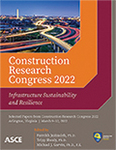Graph-Based Simulation for Cyber-Physical Attacks on Smart Buildings
Publication: Construction Research Congress 2022
ABSTRACT
As buildings evolve toward the envisioned smart building paradigm, smart buildings’ cybersecurity issues, and physical security issues are mingling. Although research studies have been conducted to detect and prevent physical (or cyber) intrusions to smart building systems (SBS), it is still unknown (1) how one type of intrusion facilitates the other and (2) how such synergic attacks compromise the security protection of whole systems. To investigate both research questions, the authors propose a graph-based testbed to simulate cyber-physical attacks on smart buildings. The testbed models both cyber and physical accesses of a smart building in an integrated graph and simulates diverse cyber-physical attacks to assess their synergic impacts on the building and its systems. In this paper, the authors present the testbed design and the developed prototype, SHSim. An experiment is conducted to simulate attacks on multiple smart home designs and to demonstrate the functions and feasibility of the proposed simulation system.
Get full access to this article
View all available purchase options and get full access to this chapter.
REFERENCES
Chi, Z., Li, Y., Liu, X., Wang, W., Yao, Y., Zhu, T., and Zhang, Y. (2020). “Countering Cross- Technology Jamming Attack.” Proceedings of the 13th ACM Conference on Security and Privacy in Wireless and Mobile Networks, WiSec ’20, New York, NY, USA, Association for Computing Machinery, 99–110.
Ciholas, P., Lennie, A., Sadigova, P., and Such, J. M. (2019). “The security of smart buildings: a systematic literature review.
Dong, B., Prakash, V., Feng, F., and O’Neill, Z. (2019). A review of smart building sensing system for better indoor environment control. Energy and Buildings, 199, 29–46.
Gao, X., Tang, S., Pishdad-Bozorgi, P., and Shelden, D. (2019). Foundational research in integrated building Internet of Things (IoT) data standards. Center for the Development and Application of Internet of Things Technologies.
Gartner. (2019). Predicts 2020: Security and Risk Management Programs, <https://www.gartner.com/en/documents/3976275/predicts-2020-security-and-risk-management-programs>. [Accessed August 25st, 2021].
Google. (2021). Google Nest, build your connected home, <https://store.google.com/us/category/connected_home?>. [Accessed August 25st, 2021].
Gómez, J. R., Vargas Montoya, H. F., and Henao, A. L. (2018). “Implementation of a wormhole attack on wireless sensor networks with xbee s2c devices.” Advances in Computing, J. E. Serrano C. and J. C. Martínez-Santos, eds., Cham, Springer International Publishing, 98–112.
Grinberg, M. (2018). Flask web development: developing web applications with Python. O’Reilly Media, Inc.
Hager, M., Schellenberg, S., Seitz, J., Mann, S., and Schorcht, G. (2012). “Secure and qos-aware communications for smart home services.” 2012 35th International Conference on Telecommu- nications and Signal Processing (TSP), 11–17.
Hu, Y., Castro-Lacouture, D., Eastman, C. M., and Navathe, S. B. (2021). Component Change List Prediction for BIM-Based Clash Resolution from a Graph Perspective. Journal of Construction Engineering and Management, 147(8), 04021085.
Huraj, L., Šimon, M., and Horák, T. (2020). “Resistance of iot sensors against ddos attack in smart home environment.” Sensors, 20(18).
Mamonova, G., and Maidaniuk, N. (2020). Mathematical Tools for the Internet of Things Analysis. Cybernetics and Systems Analysis, 56(4), 621–627.
Mundt, T., and Wickboldt, P. (2016). “Security in building automation systems - a first analysis.” 2016 International Conference On Cyber Security And Protection Of Digital Services (Cyber Security), 1–8.
Node.js. “About Node.js.” Node.js, <https://nodejs.org/en/about/>. [Accessed April 21st, 2021].
Porter, S., Tan, T., Tan, T., and West, G. (2014). “Breaking into bim: Performing static and dynamic security analysis with the aid of bim.” Automation in Construction, 40, 84–95.
React. (2021). “About React.js, <https://reactjs.org/>. [Accessed April 20th, 2021].
Skandhakumar, N., Salim, F., Reid, J., Drogemuller, R., and Dawson, E. (2016). “Graph theory based representation of building information models for access control applications.” Automation in Construction, 68, 44–51.
Sugawara, T., Cyr, B., Rampazzi, S., Genkin, D., and Fu, K. (2020). “Light commands: Laser-based audio injection attacks on voice-controllable systems.
System, S. (2021). “Smart Home Layout, <https://www.surrealsystems.com/solutions/home- solutions/smart-home-layout>. [Accessed April 18, 2021].
Trudeau, R. (1993). Introduction to Graph Theory. Dover Books on Mathematics.
West, D. B. (2001). Introduction to graph theory (Vol. 2). Upper Saddle River: Prentice hall.
Wilhelm, M., Martinovic, I., Schmitt, J., and Lenders, V. (2011). “Short Paper: Reactive Jamming in Wireless Networks—How Realistic is the Threat?.” 47–52 (06).
Zargar, S. T., Joshi, J., and Tipper, D. (2013). “A survey of defense mechanisms against distributed denial of service (ddos) flooding attacks.” IEEE Communications Surveys Tutorials, 15(4), 2046–2069.
Information & Authors
Information
Published In
History
Published online: Mar 7, 2022
Authors
Metrics & Citations
Metrics
Citations
Download citation
If you have the appropriate software installed, you can download article citation data to the citation manager of your choice. Simply select your manager software from the list below and click Download.
